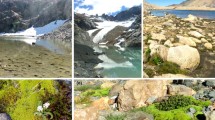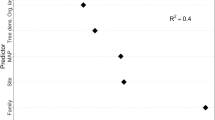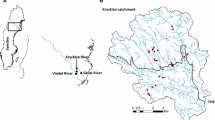Abstract
Relative to vascular plants, little is known about what factors control bryophyte communities or how they respond to successional and environmental changes. Bryophytes are abundant in boreal forests, thus changes in moss community composition and functional traits (for example, moisture and nutrient content; rates of photosynthesis and respiration) may have important consequences for ecosystem processes and microfaunal communities. Through synthesis of previous work and new analyses integrating new and published data from a long-term successional gradient in the boreal forest of northern Sweden, we provide a comprehensive view of the biotic factors (for example, vascular plant productivity, species composition, and diversity) and abiotic factors (for example, soil fertility and light transmission) that impact the moss community. Our results show that different aspects of the moss community (that is, composition, functional traits, moss-driven processes, and associated invertebrate fauna) respond to different sets of environmental variables, and that these are not always the same variables as those that influence the vascular plant community. Measures of moss community composition and functional traits were primarily influenced by vascular plant community composition and productivity. This suggests that successional shifts in abiotic variables, such as soil nutrient levels, indirectly affect the moss community via their influence on vascular plant community characteristics, whereas direct abiotic effects are less important. Among the moss-driven processes, moss litter decomposition and moss productivity were mainly influenced by biotic variables (notably the community characteristics of both vascular plants and mosses), whereas moss functional traits (primarily specific leaf area and tissue nutrient concentrations) also were important in explaining moss di-nitrogen-fixation rates. In contrast, both abiotic and biotic variables were important drivers of moss microfaunal community structure. Taken together, our results show which abiotic and biotic factors impact mosses and their associated organisms, and thus highlight that multiple interacting factors need to be considered to understand how moss communities, associated food webs, and the ecosystem processes they influence will respond to environmental change.




Similar content being viewed by others
References
Bansal S, Nilsson M-C, Wardle DA. 2012. Response of photosynthetic carbon gain to ecosystem retrogression of vascular plants and mosses in the boreal forest. Oecologia 169:661–72.
Bates JW, Farmer AM. 1992. Bryophytes and lichens in a changing environment. Oxford: Clarendon Press.
Benscoter BW, Vitt DH. 2007. Evaluating feathermoss growth: A challenge to traditional methods and implications for the boreal carbon budget. J Ecol 95:151–8.
Blok D, Heijmans MMPD, Schaepman-Strub G, van Ruijven J, Parmentier FJW, Maximov TC, Berendse F. 2011. Controls on water and energy fluxes in a Siberian tundra site. Ecosystems 14:1055–65.
Boeckner M, Collins M, Finney-Crawley J, Bateman L. 2006. The Bryofauna of remote coastal Labrador: Including a review of current Canadian records. Zootaxa 1105:1–16.
Callaghan TV, Bjorn LO, Chernov Y, Chapin T, Christensen TR, Huntley B, Ims RA, Johansson M, Jolly D, Jonasson S, Matveyeva N, Panikov N, Oechel W, Shaver G, Elster J, Jonsdottir IS, Laine K, Taulavuori K, Taulavuori E, Zockler C. 2004. Responses to projected changes in climate and UV-B at the species level. Ambio 33:418–35.
Cisneros-Dozal M, Trumbore SE, Hanson PJ. 2007. Effect of moisture on leaf litter decomposition and its contribution to soil respiration in a temperate forest. J Geophys Res 112:G01013.
Clemmensen KE, Bahr A, Ovaskainen O, Dahlberg A, Ekblad A, Wallander H, Stenlid J, Finlay RD, Wardle DA, Lindahl B. 2013. Roots and associated fungi drive long term carbon sequestration in boreal forest. Science 339:1615–18.
Cornelissen JHC, Lang SI, Soudzilovskaia NA, During HJ. 2007. Comparative cryptogam ecology: A review of bryophyte and lichen traits that drive biogeochemistry. Ann Bot 99:987–1001.
Davey ML, Heegaard E, Halvorsen R, Ohlson M, Kauserud H. 2012. Seasonal trends in the biomass and structure of bryophyte-associated fungal communities explored by 454 pyrosequencing. New Phytol 195:844–56.
Dawson TE, Mambelli S, Plamboeck AH, Templer PH, Tu KP. 2002. Stable isotopes in plant ecology. Annu Rev Ecol Syst 33:507–59.
DeLuca TH, Nilsson M-C, Zackrisson O. 2002a. Nitrogen mineralization and phenol accumulation along a fire chronosequence in northern Sweden. Oecologia 133:206–14.
DeLuca TH, Zackrisson O, Nilsson M-C, Sellstedt A. 2002b. Quantifying nitrogen-fixation in feather moss carpets of boreal forests. Nature 419:917–20.
Deluca TH, Zackrisson O, Gundale MJ, Nilsson M-C. 2008. Ecosystem feedbacks and nitrogen fixation in boreal forests. Science 320:1181.
Doncaster CC, Hooper DJ. 1961. Nematodes attacked by protozoa and tardigrades. Nematologica 6:333–5.
Elbert W, Weber B, Burrows S, Steinkamp J, Büdel B, Andreae MO, Pöschl U. 2012. Contribution of cryptogamic covers to the global cycles of carbon and nitrogen. Nat Geosci 5:459–62.
Gadea E. 1964. Publnes Inst Biol Appl Barc 37:73–93.
Garnier E, Lavorel S, Ansquer P, Castro H, Cruz P, Dolezal J, Eriksson O, Fortunel C, Freitas H, Golodets C, Grigulis K, Jouany C, Kazakoul E, Kigel J, Kleyer M, Lehsten V, Lepš J, Meier T, Pakeman R, Papadimitriou M, Papanastasis VP, Quested H, Quétier F, Robson M, Roumet C, Rusch G, Skarpe C, Sternberg M, Theau J-P, Thébault A, Vile D, Zarovali MP. 2007. Assessing the effects of land-use change on plant traits, communities and ecosystem functioning in grasslands: A standardized methodology and lessons from an application to 11 European sites. Ann Bot 99:967–85.
Gerson U. 1982. Bryophytes and invertebrates. In: Smith AJE, Ed. Bryophyte ecology. New York: Chapman and Hall. p 291–332.
Glime JM. 2013. Tardigrade Survival. Chapt. 5-1. In: Glime, JM. Bryophyte Ecology. Volume 2. Bryological Interaction. Ebook 5-1-1 sponsored by Michigan Technological University and the International Association of Bryologists. Last updated 2 July 2013 and available at www.bryoecol.mtu.edu.
Gornall JL, Jonsdottir IS, Woodin SJ, van der Wal R. 2007. Arctic mosses govern below-ground environment and ecosystem processes. Oecologia 153:931–41.
Gundale MJ, Wardle DA, Nilsson M-C. 2010. Vascular plant removal effects on biological N fixation vary across a boreal forest island gradient. Ecology 91:1704–14.
Gundale MJ, Fajardo A, Lucas RW, Nilsson M-C, Wardle DA. 2011. Resource heterogeneity does not explain the diversity-productivity relationship across a boreal island fertility gradient. Ecography 34:887–96.
Gundale MJ, Nilsson M-C, Bansal S, Jäderlund A. 2012a. The interactive effects of temperature and light on biological nitrogen fixation in boreal forests. New Phytol 194:453–63.
Gundale MJ, Wardle DA, Nilsson M-C. 2012b. The effect of altered macroclimate on N-fixation by boreal feather mosses. Biol Lett 8:805–8.
Gundale MJ, Bach LH, Nordin A. 2013. The impact of simulated chronic nitrogen deposition on the biomass and N2-fixation activity of two boreal feather moss–cyanobacteria associations. Biol Lett 9:20130797.
Hansen MC, Stehman SV, Potapov PV. 2010. Quantification of global gross forest cover loss. Proc Natl Acad Sci USA 107:8650–5.
Hayes DJ, McGuire AD, Kicklighter DW, Gurney KR, Burnside TJ, Melillo JM. 2011. Is the northern high-latitude land-based CO(2) sink weakening? Global Biogeochem Cy 25:GB3018.
Hengherr S, Heyer AG, Köhler H-R, Schill RO. 2008. Trehalose and anhydrobiosis in tardigrades: evidence for divergence in responses to dehydration. FEBS J 275:281–8.
Hyodo F, Wardle DA. 2009. Effects of ecosystem retrogression on stable nitrogen and carbon isotopes of plants, soils and consumer organisms in boreal forest islands. Rapid Commun Mass Spectrom 23:1892–8.
Ininbergs K, Bay G, Rasmussen U, Wardle DA, Nilsson M-C. 2011. Composition and diversity of nifH genes of nitrogen-fixing cyanobacteria associated with boreal forest feather mosses. New Phytol 192:507–17.
Jonsson M, Wardle DA. 2008. Context dependency of litter-mixing effects on decomposition and nutrient release across a long-term chronosequence. Oikos 117:1674–82.
Jonsson M, Wardle DA. 2010. Structural equation modelling reveals plant-community drivers of carbon storage in boreal forest ecosystems. Biol Lett 6:116–19.
Kauserud H, Mathiesen C, Ohlson M. 2008. High diversity of fungi associated with living parts of boreal forest bryophytes. Botany (Botanique) 86:1326–33.
Kinchin IM. 1989. The moss fauna 2: Nematodes. J Biol Educ 23:37–40.
Lagerström A, Nilsson M-C, Zackrisson O, Wardle DA. 2007. Ecosystem input of nitrogen through biological fixation in feather mosses during ecosystem retrogression. Funct Ecol 21:1027–33.
Lange OL, Hahn SC, Muller G, Meyer A, Tenhunen JD. 1996. Upland tundra in the foothills of the Brooks Range, Alaska: Influence of light, water content and temperature on CO2 exchange of characteristic lichen species. Flora 191:67–83.
Lindo Z, Nilsson M-C, Gundale MJ. 2013. Bryophyte–cyanobacteria associations as regulators of the northern latitude carbon balance in response to global change. Glob Change Biol 19:2022–35.
Lindo Z, Gonzalez A. 2010. The bryosphere: An integral and influential component of the Earth’s biosphere. Ecosystems 13:612–27.
McSorley R. 2003. Adaptations of nematodes to environmental extremes. Fla Entomol 86:138–42.
Overgaard-Nielsen C. 1948. Studies on the soil microfauna. I. The moss-inhabiting nematodes and rotifers. Naturvidenskabelige Skrifter Laerde Selsk Skrifter, Aarhus 1948(1):1–98.
Pan YD, Birdsey RA, Fang JY, Houghton R, Kauppi PE, Kurz WA, Phillips OL, Shvidenko A, Lewis SL, Canadell JG, Ciais P, Jackson RB, Pacala SW, McGuire AD, Piao SL, Rautiainen A, Sitch S, Hayes D. 2011. A large and persistent carbon sink in the world’s forests. Science 333:988–93.
Peltzer DA, Wardle DA, Allison VJ, Baisden WT, Bardgett RD, Chadwick OA, Condron LM, Parfitt RL, Porder S, Richardson SJ, Turner BL, Vitousek PM, Walker J, Walker LR. 2010. Understanding ecosystem retrogression. Ecol Monogr 80:509–29.
Renhorn KE, Esseen PA, Palmqvist K, Sundberg B. 1997. Growth and vitality of epiphytic lichens I. Responses to microclimate along a forest edge-interior gradient. Oecologia 109:1–9.
Sánchez-Moreno S, Ferris H, Noemí G. 2008. Role of tardigrades in the suppressive service of a soil food web. Agri Ecosyst Environ 124:187–92.
Schöllhorn R, Burris RH. 1967. Acetylene as a competitive inhibitor of nitrogen fixation. Proc Natl Acad Sci USA 58:213–18.
Skre O, Oechel WC. 1981. Moss functioning in different taiga ecosystems in interior Alaska. Oecologia 48:50–9.
Sonesson M, Gehrke C, Tjus M. 1992. CO2 environment, microclimate and photosynthetic characteristics of the moss Hylocomium splendens in a subarctic habitat. Oecologia 92:23–9.
Spaull VW. 1973. Qualitative and quantitative distribution of soil nematodes of Signy Island, South Orkney Islands. Brit Antarct Survey Bull 33–34:177–84.
Stewart KJ, Lamb EG, Coxson DS, Siciliano SD. 2011. Bryophyte-cyanobacterial associations as a key factor in N(2)-fixation across the Canadian Arctic. Plant Soil 344:335–46.
Street LE, Subke J-A, Sommerkorn M, Sloan V, Ducrotoy H, Phoenix GK, Williams M. 2013. The role of mosses in carbon uptake and partitioning in arctic vegetation. New Phytol 199:163–75.
Turetsky MR. 2003. The role of bryophytes in carbon and nitrogen cycling. Bryologist 106:395–409.
Turetsky MR, Mack MC, Hollingsworth TN, Harden JW. 2010. The role of mosses in ecosystem succession and function in Alaska’s boreal forest. Can J Forest Res 40:1237–64.
Turetsky MR, Bond-Lamberty B, Euskirchen E, Talbot J, Frolking S, McGuire AD, Tuittila E-S. 2012. The resilience and functional role of moss in boreal and arctic ecosystems. New Phytol 196:49–67.
Wardle DA, Zackrisson O, Hörnberg G, Gallet C. 1997. The influence of island area on ecosystem properties. Science 277:1296–9.
Wardle DA, Hörnberg G, Zackrisson O, Kalela-Brundin M, Coomes DA. 2003. Long-term effects of wildfire on ecosystem properties across an island area gradient. Science 300:972–5.
Wardle DA, Bardgett RD, Klironomos JN, Setälä H, van der Putten WH, Wall DH. 2004. Ecological linkages between above and belowground biota. Science 304:1629–33.
Wardle DA, Zackrisson O. 2005. Effects of species and functional group loss on island ecosystem properties. Nature 435:806–10.
Wardle DA, Jonsson M, Bansal S, Bardgett RD, Gundale MJ, Metcalfe DB. 2012. Linking vegetation change, carbon sequestration and biodiversity: insights from island ecosystems in a long-term natural experiment. J Ecol 100:16–30.
Wharton DA. 2004. Survival strategies. In: Gaugler R, Bilgrami AL, Eds. Nematode Behaviour. Cambridge, MA: CABI Publishing. p 371–400.
Yeates GW, Bongers T, De Goede RGM, Freckman DW, Georgieva SS. 1993. Feeding habits in soil nematode families and genera: an outline for soil ecologists. J Nematol 25:315–31.
Acknowledgments
We thank a great number of field assistants—too many to list here—that over the years have helped out on the islands. Financial support was provided by the Swedish Research Councils Formas (MJ, PK, MCN), Vetenskapsrådet (DAW, MJ), and a Wallenberg Scholars award (DAW).
Author information
Authors and Affiliations
Corresponding author
Additional information
Author contributions
All authors conceived and designed the study. Each author collected one part, or several parts, of the data, of which moss decomposition (Micael Jonsson) and microfauna (Paul Kardol) were not previously published. Micael Jonsson performed all statistical analyses and led the writing of the manuscript. All authors took part in the writing.
Electronic supplementary material
Below is the link to the electronic supplementary material.
Rights and permissions
About this article
Cite this article
Jonsson, M., Kardol, P., Gundale, M.J. et al. Direct and Indirect Drivers of Moss Community Structure, Function, and Associated Microfauna Across a Successional Gradient. Ecosystems 18, 154–169 (2015). https://doi.org/10.1007/s10021-014-9819-8
Received:
Accepted:
Published:
Issue Date:
DOI: https://doi.org/10.1007/s10021-014-9819-8




